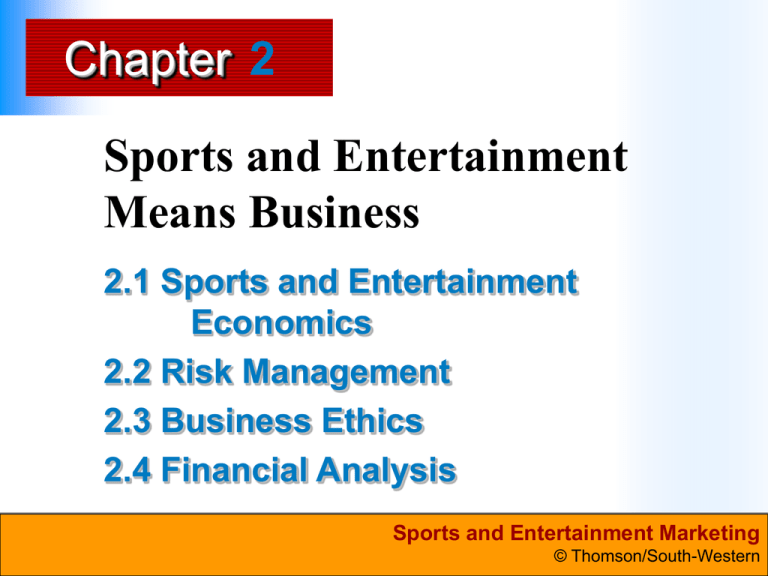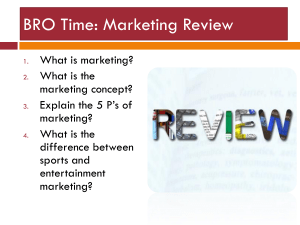Chapter 2 PPT Sports and Entertainment Means Business
advertisement

Chapter 2 Sports and Entertainment Means Business 2.1 Sports and Entertainment Economics 2.2 Risk Management 2.3 Business Ethics 2.4 Financial Analysis Sports and Entertainment Marketing © Thomson/South-Western Winning Strategies EMI one of the largest music content providers cost savings achieved through outsourcing of manufacturing in 2005, income grew due to legitimate sales of digital music the music industry embraces ever-changing technology and helps drive the economy Chapter 2 Slide 2 Sports and Entertainment Marketing © Thomson/South-Western Lesson 2.1 Sports and Entertainment Economics Goals Define profit and explain the profit motive. Describe types of economic utility. Chapter 2 Slide 3 Sports and Entertainment Marketing © Thomson/South-Western Terms profit profit motive economics economic utility Chapter 2 Slide 4 Sports and Entertainment Marketing © Thomson/South-Western THE PROFIT MAKERS profit the amount of money remaining from revenues after all expenses are paid Chapter 2 Slide 5 Sports and Entertainment Marketing © Thomson/South-Western revenue the money a business receives from the sales of goods and services profit motive making decisions to use resources in ways that result in the greatest profit Chapter 2 Slide 6 Sports and Entertainment Marketing © Thomson/South-Western Cultural Opportunities for Profits Worldwide distribution revenue is critical for movie profits. Chapter 2 Slide 7 Sports and Entertainment Marketing © Thomson/South-Western Marketers must understand the markets in which sales occur. China has a tremendous movie market. the government censors movies for content pirated movies diminish theater sales Chapter 2 Slide 8 Sports and Entertainment Marketing © Thomson/South-Western In addition to U.S. ticket sales, name two other large sources of revenue for U.S. film studios. Chapter 2 Slide 9 International Ticket Sales DVD sales DVD Rentals Sale of Movie Themed Merchandise Sports and Entertainment Marketing © Thomson/South-Western ECONOMICS economics the study of how goods and services are produced, distributed, and consumed - Chapter 2 Slide 10 Sports and Entertainment Marketing © Thomson/South-Western macroeconomics the study of the economics of the entire society microeconomics the study of the relationships between individual consumers and producers Sports and entertainment marketers are focused on microeconomics. relationships with consumers Chapter 2 Slide 11 Sports and Entertainment Marketing © Thomson/South-Western Sports and Entertainment Economics economic utility the amount of satisfaction a person receives from the consumption of a particular product or service Chapter 2 Slide 12 Sports and Entertainment Marketing © Thomson/South-Western Types of Utility form utility when the physical characteristics of a product or service are improved time utility making the product or service available when the customer wants it place utility the product is available where it is wanted possession utility the product or service is available at an affordable price Chapter 2 Slide 13 Sports and Entertainment Marketing © Thomson/South-Western List four types of economic utility. Chapter 2 Slide 14 Sports and Entertainment Marketing © Thomson/South-Western Lesson 2.2 Risk Management Goals Define risk and describe the categories and classifications of risk. Name and describe four strategies for risk management. Chapter 2 Slide 15 Sports and Entertainment Marketing © Thomson/South-Western Terms risk risk management liable Chapter 2 Slide 16 Sports and Entertainment Marketing © Thomson/South-Western RISKING IT ALL risk the possibility of financial gain or loss or personal injury Chapter 2 Slide 17 Sports and Entertainment Marketing © Thomson/South-Western Categories of Risk natural risk occurs from unavoidable weather conditions human risk dishonest customers and employees inadequately trained employees economic risk occurs due to changes in the economy Chapter 2 Slide 18 Sports and Entertainment Marketing © Thomson/South-Western Additional Classification of Risk gain or loss risk speculative risk either a gain or loss could result pure risk a chance of an event occurring that could only result in a loss Chapter 2 Slide 19 Sports and Entertainment Marketing © Thomson/South-Western controllable risk if a loss can be prevented or the likelihood of its occurrence reduced uncontrollable risk nothing can be done to prevent the risk Chapter 2 Slide 20 Sports and Entertainment Marketing © Thomson/South-Western insurable risk a pure risk for which the chances of loss are predictable and the amount of the loss can be estimated uninsurable risk the chance that a dollar loss could occur the amount of the loss cannot be estimated Chapter 2 Slide 21 Sports and Entertainment Marketing © Thomson/South-Western What is meant by a controllable risk? Chapter 2 Slide 22 Sports and Entertainment Marketing © Thomson/South-Western MANAGING RISK risk management preventing, reducing, or lessening the negative impacts of risk by using the strategies of risk avoidance, risk insurance, risk transfer, and/or risk retention Chapter 2 Slide 23 Sports and Entertainment Marketing © Thomson/South-Western Risk Avoidance Sports and entertainment marketers need to plan to avoid risky situations. liable the business is legally responsible for damages that occur Chapter 2 Slide 24 Sports and Entertainment Marketing © Thomson/South-Western Risk Insurance risk insurance pays for predictable losses premium cost of insurance Chapter 2 Slide 25 Sports and Entertainment Marketing © Thomson/South-Western Risk Transfer Some risks can be transferred to another company or even to the consumer. contracting with third parties for services including releases from liability on event tickets Chapter 2 Slide 26 Sports and Entertainment Marketing © Thomson/South-Western Risk Retention risk retention assuming the cost of an uninsurable risk risk retention groups similar businesses facing similar risks pool resources resources are distributed to members that have a loss Chapter 2 Slide 27 Sports and Entertainment Marketing © Thomson/South-Western Briefly describe four strategies for managing risk. Chapter 2 Slide 28 Sports and Entertainment Marketing © Thomson/South-Western Lesson 2.3 Business Ethics Goals Define ethics. Discuss the impacts of unethical behavior. Chapter 2 Slide 29 Sports and Entertainment Marketing © Thomson/South-Western Terms ethics principles Chapter 2 Slide 30 Sports and Entertainment Marketing © Thomson/South-Western DO ETHICS COUNT? ethics a system of deciding what is right or wrong in a reasoned and impartial manner Business should be conducted with integrity, trust, and fairness. Chapter 2 Slide 31 Sports and Entertainment Marketing © Thomson/South-Western Ethics and Character Matter principles high standards of rules and guidelines character development a progression in behavior where people advance from childish behavior to mature behavior based on principles Young people need good role models. Chapter 2 Slide 32 Sports and Entertainment Marketing © Thomson/South-Western How does a person’s character develop? Chapter 2 Slide 33 Sports and Entertainment Marketing © Thomson/South-Western BUSINESS BEHAVIOR People and businesses should act ethically while pursuing a profit. Chapter 2 Slide 34 Sports and Entertainment Marketing © Thomson/South-Western Seeking an Advantage Sometimes it is hard to continue to act ethically when you observe people who receive a benefit from acting unethically. Chapter 2 Slide 35 Sports and Entertainment Marketing © Thomson/South-Western When Being Bad Profits Only fans can really influence the behavior of ethically challenged athletes and celebrities. Chapter 2 Slide 36 Sports and Entertainment Marketing © Thomson/South-Western Effective and Ethical Good decisions are both ethical and effective. Good decisions are the right choices for the long term. Chapter 2 Slide 37 Sports and Entertainment Marketing © Thomson/South-Western How can the bad behavior of celebrities be controlled? Chapter 2 Slide 38 Sports and Entertainment Marketing © Thomson/South-Western Lesson 2.4 Financial Analysis Goals Discuss sources of funding and revenue for sports and entertainment businesses. Describe four tools for financial analysis. Chapter 2 Slide 39 Sports and Entertainment Marketing © Thomson/South-Western Terms return on investment forecast budget balance sheet income statement Chapter 2 Slide 40 Sports and Entertainment Marketing © Thomson/South-Western IT TAKES MONEY Profit is the primary purpose of sports and entertainment marketing. Chapter 2 Slide 41 Sports and Entertainment Marketing © Thomson/South-Western Finding Funding Investors generally provide the funding for an event to cover all the costs that must be incurred before tickets are ever sold. Chapter 2 Slide 42 Sports and Entertainment Marketing © Thomson/South-Western return on investment the income from a venture that is distributed to investors Chapter 2 Slide 43 Sports and Entertainment Marketing © Thomson/South-Western Money Sources Funds to repay investors are raised through ticket sales broadcast rights licensing facilities Chapter 2 Slide 44 Sports and Entertainment Marketing © Thomson/South-Western Name three sources of revenue from sports and entertainment. Chapter 2 Slide 45 Sports and Entertainment Marketing © Thomson/South-Western WHERE IS THE MONEY? forecast a plan that predicts the expenses to be incurred and the revenues to be received Chapter 2 Slide 46 Sports and Entertainment Marketing © Thomson/South-Western BUDGETS budget a plan for how available funds will be spent The purpose of a budget is to control costs so they do not exceed the funds available. Chapter 2 Slide 47 Sports and Entertainment Marketing © Thomson/South-Western Financial Statements balance sheet net worth = assets – liabilities shows net worth at a specific point in time income statement shows revenues and expenses for a specific period of time reveals company’s profit or loss Chapter 2 Slide 48 Sports and Entertainment Marketing © Thomson/South-Western What is the purpose of a forecast? Chapter 2 Slide 49 Sports and Entertainment Marketing © Thomson/South-Western PERFORMANCE INDICATORS EVALUATED Communicate pricing strategies for supply and demand. Analyze relevant data to determine varying ticket prices for home games. Explain the need for and use of additional revenue from higher-priced tickets. Chapter 2 Slide 50 Sports and Entertainment Marketing © Thomson/South-Western Demonstrate knowledge of appropriate pricing strategies. Explain the benefits of increased revenue for consumers of foot-ball tickets. Chapter 2 Slide 51 Sports and Entertainment Marketing © Thomson/South-Western THINK CRITICALLY 1. Why have an increasing number of universities varied ticket prices to games based upon the opponent? 2. Why must universities consider the consumer before raising ticket prices? 3. If games become to expensive to attend, what other options do consumers have to watch the games? 4. How much revenue would be generated from the seven games if ticket prices were $40 all season long? Chapter 2 Slide 52 Sports and Entertainment Marketing © Thomson/South-Western








